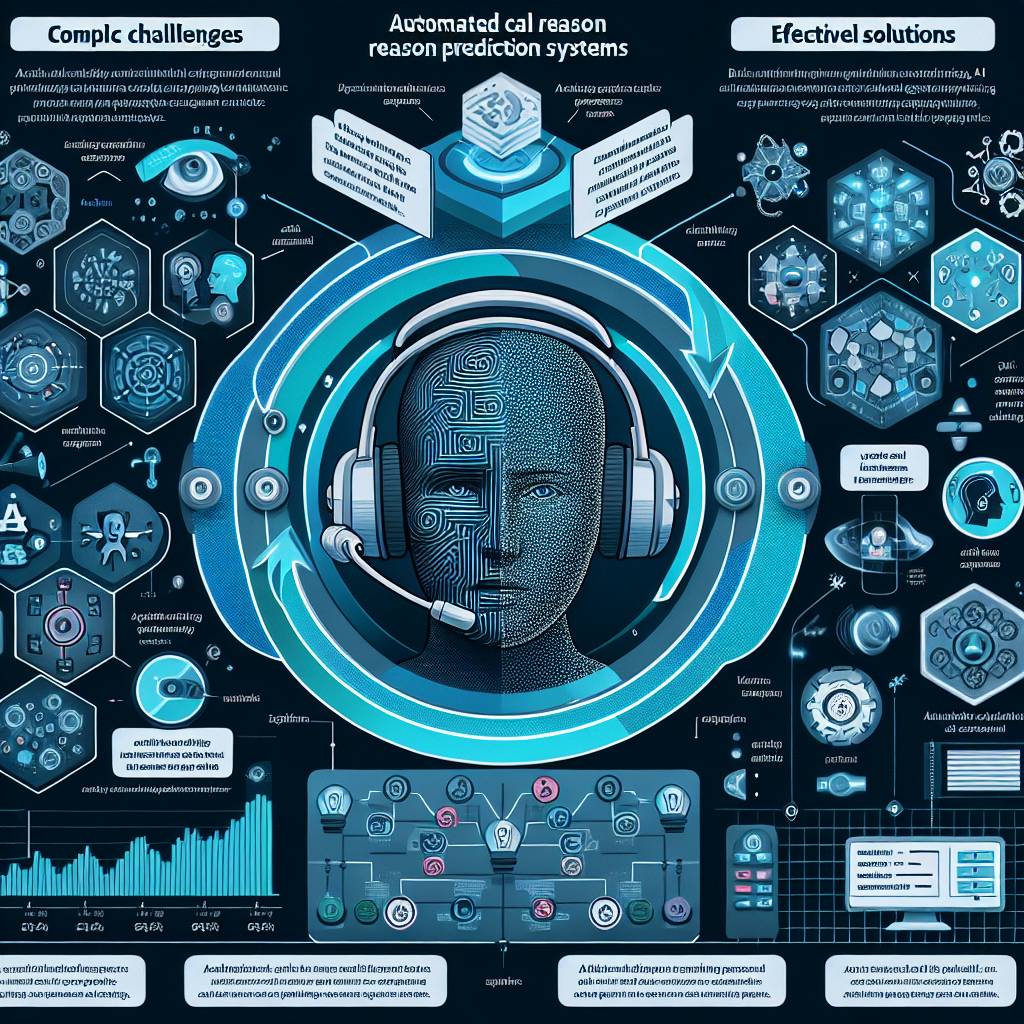
With the ever-evolving world of technology, businesses are continually seeking innovative strategies to enhance customer service. One such groundbreaking technology trend is the automated call reason prediction. This predictive technology uses artificial intelligence (AI) and machine learning (ML) to anticipate the reason for a customer's call, even before the agent picks up the phone. With predictive analytics, companies not only streamline their customer service processes but also significantly improve the customer experience.

The primary objectives of call reason prediction are to enhance customer satisfaction, reduce waiting time, and make customer service more efficient. When a customer calls, the AI-powered system analyzes the caller's history, order information, and other related data to predict the primary reason for the call. This information allows agents to be better prepared with apt solutions before they engage with the customer, thus making the troubleshooting process quicker and more efficient. Consequently, companies adopting this technology benefit from faster response times and highly satisfied customers.
The implementation of call reason prediction presents various benefits. The most noteworthy being the enhancement of agent performance. Agents equipped with the knowledge of the customer's issue even before the call begins can provide solutions effectively. The result is a significant improvement in customer satisfaction as well as agent productivity.
In a world where outstanding customer service is the key to business success, the use of predictive technology, specifically automated call reason prediction, has become crucial. This customer service strategy has proven its worth and will undoubtedly continue to play a significant role in shaping the future of customer service.
As customer experience stands at the pinnacle of business success, modern contact centers have the potential to significantly enhance the most crucial touchpoint, the customer call, with Artificial Intelligence (AI). This technological adoption can lead to a revolution in the approach of handling customer inquiries by accurately predicting the reason for a call: a concept known as automated call reason prediction.
At the core of this advancement lie two transformative technologies: Machine Learning (ML) and Natural Language Processing (NLP). Machine learning utilizes algorithms to analyze historical customer-call data, identify patterns within, and learn from these patterns to make future predictions. Learn more about the application of ML in call centers.
Natural Language Processing, on the other hand, goes a step further by comprehending, interpreting, and potentially predicting the customer’s intention based on their initial inputs during the call. NLP can efficiently analyze phrases and comments made by a customer and cross-verify it against a knowledge base to determine potential reasons for the call.
By incorporating AI in call reason prediction, businesses enable their agents to have a high-level understanding of the customer’s needs before engaging in conversation. This predictive insight drastically reduces resolution time and escalations while improving the overall customer experience. It empowers agents by giving them a head start in preparations with relevant solutions, thereby raising their performance and augmenting customer satisfaction.
In conclusion, adopting AI technologies for automated call reason prediction is an innovative approach that not only betters customer service but also provides valuable data for constant improvement. 'Let the machines do the thinking' seems to be the mantra for the future of customer service. Unravel more about the influential aspect of AI in shaping the future of customer service.
Automated Call Reason Prediction is a rapidly advancing technology with the ability to revolutionize the way businesses handle customer service. This AI-based technology can decipher the reason behind a customer's call just from the content of their pre-call communication, giving agents a head start and shaping a seamless customer interaction.[source]

Incorporating such predictive technologies into existing telecommunications systems is a strategic process involving a few key steps. The first is integration. Solutions offered by vendors often come with APIs (Application Programming Interfaces) that should be compatible with the company's current telecommunications infrastructure. [source]
Secondly, the process of data preparation is critical. Past communications need to be processed and laced with relevant features to train the AI models. It's important to note that this phase requires considerable balance since the quality and relevance of data significantly impact the precision of predictions. [source]
Post data preparation, the next step is the testing and validation of models, an exhaustive process aimed at fine-tuning the system for accuracy. This iterative process continually refines the model until it achieves satisfactory performance. [source]
Finally, there's the deployment stage. Once the models are validated, they're released in a real-time call environment. However, their learning doesn’t stop there. They keep evolving and learning from new interactions, rendering an improved service over time. [source]
Every step in this process, from integration through deployment, plays a critical role in preparing the agents with relevant information right at the outset, setting the pace for efficient and gratifying customer interactions.
In the digital milieu, Automated Call Reason Prediction has emerged as a game-changer, enhancing the manner in which businesses interact with their customers, and comprehending their needs. This section features some potent cases that demonstrate the efficacy of call reason prediction in improving customer service and operational efficiency.
One exemplary case is the transition of Affinity Plus Federal Credit Union. The credit union used an integrated predictive model in its call center, which was able to anticipate the purpose of the customers' calls. By analyzing previous call history and customer profiles, agents were poised with accurate information even before the call started. This predictive assistance not only streamlined the call process but also significantly fostered customer satisfaction.
Another successful adaptation of call reason prediction involves the Vodafone Intelligent Call Steering project. In this project, natural language processing was comprehensively utilized to predict and understand the customers' concerns. The implementation resulted in a massive reduction of call waiting time and improvement in first-call resolution.
Furthermore, the Southwest Airlines call centers also significantly transformed their operations thanks to call reason prediction. They utilized advanced analytics and prediction models to accumulate pertinent information about the customer and their possible purpose of call. This efficient servicing approach expedited their operations and granted a boost in their customer service satisfaction levels.
This selection of case studies unequivocally illustrates that Automated Call Reason Prediction is a veritable asset, amplifying operational efficiency and optimizing the overall customer service experience. Real-time customer insights combined with informed agent assistance invariably lead to better business results and improved satisfaction levels.
Automated Call Reason Prediction presents a progressive step in enhancing call center efficiency and agent productivity. However, there are associated challenges in its implementation and utilization. On the bright side, practical solutions have been devised to tackle these challenges.

One common challenge is data quality and integrity. The predictive accuracy of these systems is directly reliant on the quality of historical data used for training. Dirty, incomplete, or outdated data hugely affects the model's accuracy source. An effective solution involves a thorough initial data cleansing and routine data updates, ensuring high-quality data is always on hand for accurate predictions.
Another significant downside is privacy and security. Customers might feel their privacy is being invaded due to the predictive nature of these systems. To address this concern, call centers must enforce stringent data security measures and thoroughly inform their clients about the operation and purpose of automated predictive systems source.
Finally, there's the problem of technology integration. These predictive systems may be difficult to integrate with existing software and hardware infrastructures within traditional call centers. It is thus essential to select adaptable automated prediction tools that can seamlessly sync with existing tech setups source.
Overall, automated call reason prediction systems present transformative possibilities for call centers. While challenges exist, the solutions available continue to evolve, ensuring users can adopt these systems efficiently, leveraging them for improved customer service.
With the continuous technological advancements in the field of artificial intelligence (AI), the future of automated call reason prediction promises to usher in a new era of customer service. AI-driven solutions will become smarter, more responsive, and even more personalized over time. emerging trends in this realm are set to offer a transformative approach to the way businesses handle their customer communications.
Real-time information processing is expected to change the fundamentals significantly. AI-based predictors will become capable of making instant interpretations, allowing for a seamless deciphering of call intentions before a human operator gets involved. This ability to rapidly process and analyze call data in real time will undoubtedly provide agents with the necessary context to handle customer queries more efficiently.
Moreover, the integration of big data analytics with AI call prediction models is another fascinating trend to watch out for. Combining these powerful technologies will lead to a higher level of understanding and prediction accuracy, providing businesses with unprecedented insights into their customer behavior patterns.
Integration of emotional intelligence in AI is another development worthy of note. AI systems in the future will be able to comprehend the emotional state of the caller, facilitating a more empathetic customer service approach. As the complexity of machine learning algorithms improves, so too will their ability to discern subtleties in human communication.
In conclusion, the coming years in automated call reason prediction will witness a revolutionary shift, redefining customer-business interactions at large. As we stay tuned to advancements in AI and machine learning, businesses must gear up to harness these emerging technological trends to deliver superior customer service experiences, fuelled by relevant and actionable data.
Start your free trial for My AI Front Desk today, it takes minutes to setup!








